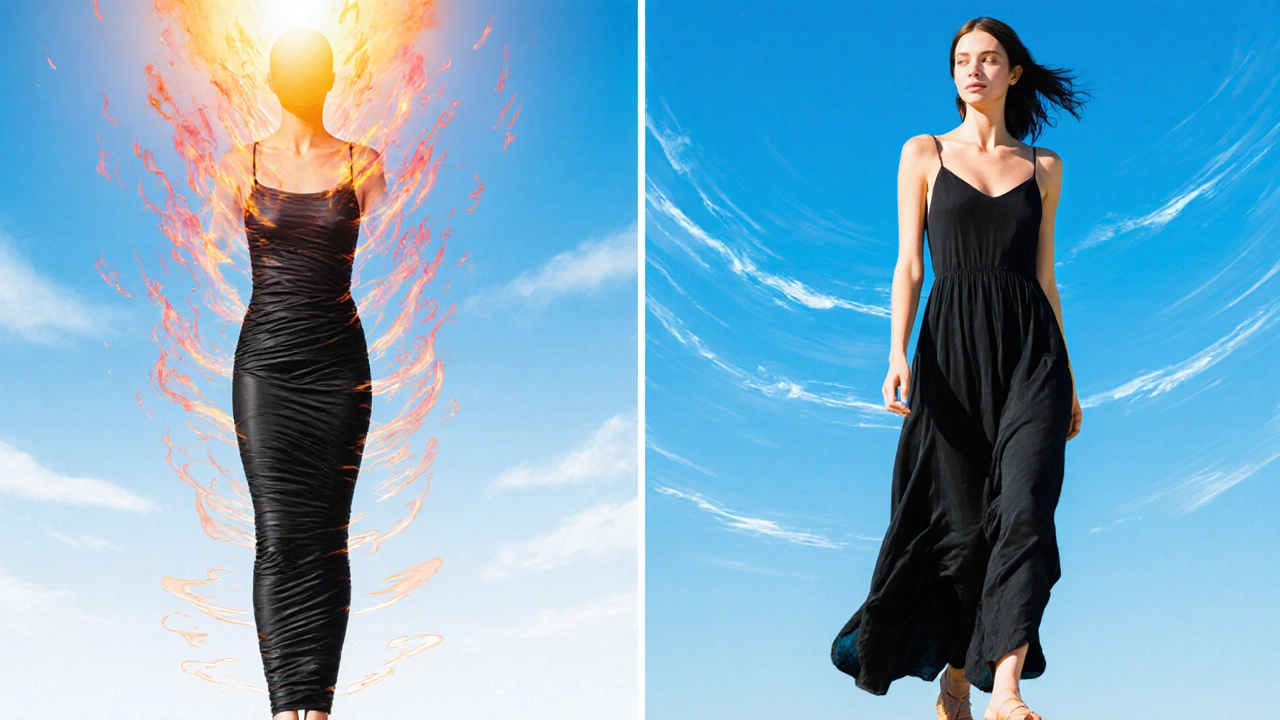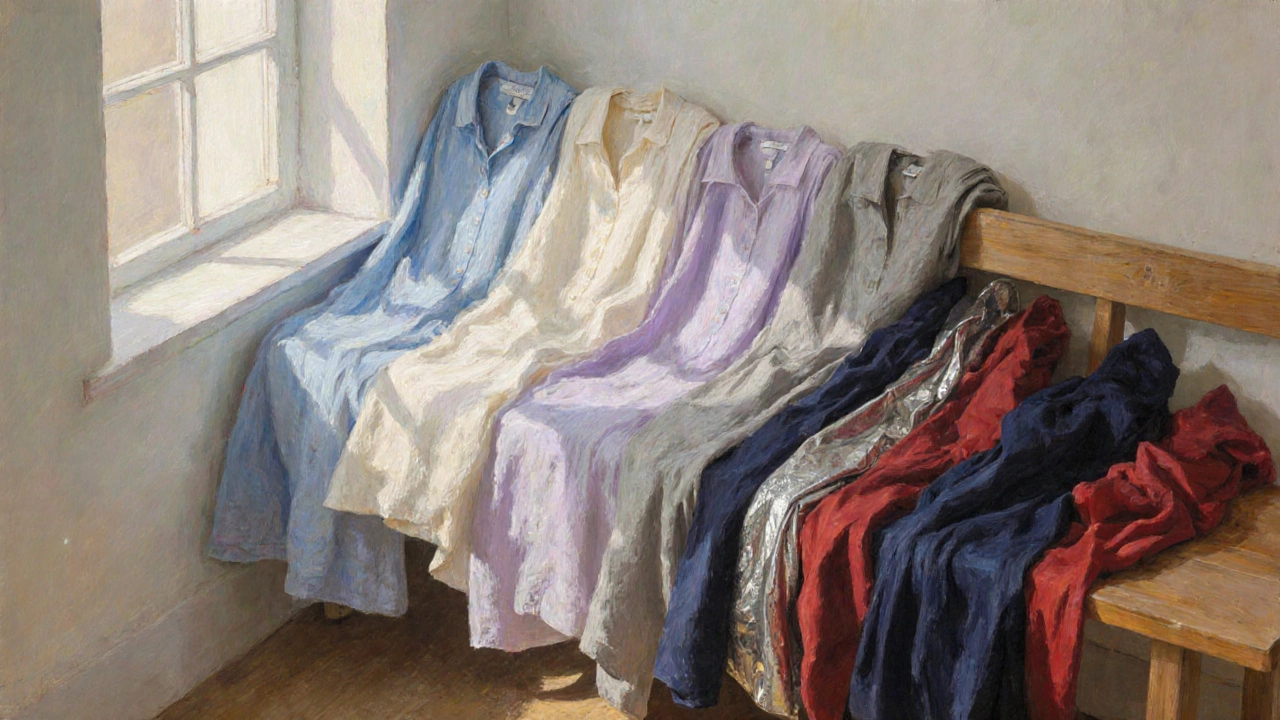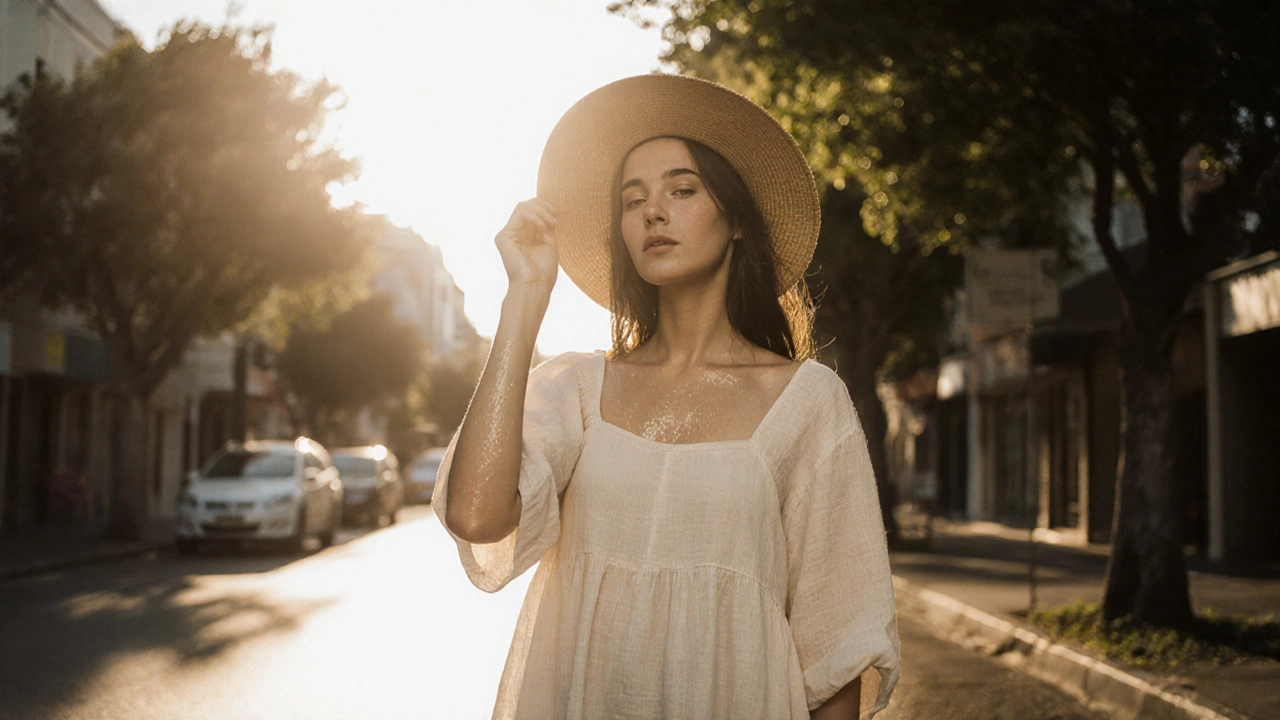Summer Clothing Calculator
Your Climate
Your Activity
Color Choice
Fabric Selection
Fit Preference
When the sun beats down and the air feels thick, what you wear isn’t just about style-it’s about survival. You’ve probably heard the old advice: wear white to stay cool. But is that really the best choice? And what about black? Or bright red? The truth is, the color of your clothes affects how much heat your body absorbs, how much sweat you lose, and how comfortable you feel-especially in places like Auckland where summer can hit 30°C with high humidity.
Why Color Matters in Hot Weather
Not all colors are created equal when it comes to heat. Dark colors like black, navy, or deep brown absorb more sunlight. That means they turn more of that solar energy into heat, which then gets trapped against your skin. Light colors, especially white, reflect most of that light. But reflection isn’t the whole story. Fabric type, weave, and fit matter just as much. A loose white cotton dress will beat a tight black polyester one every time.
Here’s what actually happens: when sunlight hits fabric, some wavelengths bounce off (reflection), and others get soaked up (absorption). The absorbed energy becomes heat. Darker colors absorb up to 90% of visible light. White reflects about 80%. That’s why standing in the sun in a black shirt feels like sitting on a hot pavement.
The Real Winner: Light Colors, But Not Just White
White is still the top performer. It reflects the most light and stays the coolest under direct sun. But don’t overlook other light shades. Pastel blues, soft grays, pale yellows, and even light lavender all reflect a high percentage of sunlight-sometimes nearly as well as white. And here’s the kicker: they’re less likely to show sweat stains.
Studies from the American Society of Heating, Refrigerating and Air-Conditioning Engineers show that light-colored clothing can reduce heat gain by up to 20% compared to dark colors. That’s not just comfort-it’s a drop in core body temperature over time. In practical terms? You’ll feel less sticky, less tired, and less likely to overheat during a midday walk or a garden party.
One thing to watch: pure white can look harsh under bright sun and may show dirt easily. That’s why many people in hot climates wear off-white, cream, or linen-beige. These tones still reflect light well but feel more natural and forgiving.
What About Black? Yes, It Can Work
Wait-didn’t I just say black is bad? It is… usually. But there’s an exception. In dry, sunny climates like parts of the Middle East or North Africa, traditional robes are often black. Why? Because they’re loose, flowing, and made from breathable fabrics like cotton or linen. The air moves between the fabric and the skin, creating a cooling effect called convective cooling. The black fabric absorbs heat, but because it’s not touching the body, the heat rises and escapes upward instead of sinking into your skin.
That’s the key: fit and airflow. A tight black dress in humid Auckland? You’ll sweat buckets. A loose, flowy black maxi dress made of rayon or viscose? It might actually keep you cooler than a tight white one. The fabric breathes, the shape lets air circulate, and the heat rises away from your body.
So don’t write off black entirely. Just make sure it’s not clinging to you.

Colors to Avoid in Summer
Some colors are just bad news in heat. Deep reds, forest greens, and navy blues absorb a lot of light and don’t offer much in return. They look great in photos, but under real sun, they turn into heat traps. A navy summer dress might feel fine in the shade, but step into direct sunlight and you’ll feel the difference immediately.
Also avoid metallics like gold or silver. They may seem reflective, but they’re often coated in plastic or synthetic films that trap heat. And shiny fabrics? They reflect light back at you-sometimes right into your eyes-while still holding onto heat.
What About Patterns?
Patterns don’t change the overall color’s heat absorption much. A floral dress with mostly white and light pastels will still perform like a light-colored garment. But a dress with dark black flowers on a white background? The dark parts will still absorb heat. So focus on the dominant color. If 70% of the dress is light, you’re still good.
Stripes and geometric prints? Fine. As long as the base tone is light. A white base with thin navy stripes? Still cool. A navy base with thin white stripes? You’re better off picking something else.
Fabric Matters More Than You Think
Color is only half the battle. The fabric determines how well your body can cool itself. Cotton, linen, rayon, and bamboo are top choices. They’re breathable, absorb moisture, and let air move through them. Polyester, nylon, and spandex? They trap heat and sweat. Even if you’re wearing white, a polyester blend will feel hotter than a black linen dress.
Look for terms like “breathable,” “moisture-wicking,” or “lightweight” on the label. Natural fibers are your friends. Linen, in particular, is a game-changer. It’s loose, airy, and dries quickly. A linen sundress in cream will outperform any synthetic white dress, no matter the color.

Real-World Tips for Auckland Summers
Auckland summers are humid. That means sweat doesn’t evaporate as quickly. So you need clothes that help it along. Here’s what works:
- Choose loose fits-tight clothes stick to skin and block airflow.
- Go for V-necks or open backs-they let heat escape from your neck and shoulders.
- Wear a wide-brimmed hat. It shades your head and reduces the heat load on your whole body.
- Carry a light scarf. If you’re in a chilly office after a hot walk, a thin cotton wrap is better than a heavy jacket.
- Wear sandals or open shoes. Your feet need to breathe too.
One thing I’ve noticed: people who wear light-colored, loose cotton dresses in summer don’t just look cooler-they move differently. They’re less sluggish, less irritable, less likely to cut their day short because they’re overheating.
Final Answer: What’s the Best Color?
The best color to wear in hot weather is light-especially white, cream, or pale pastels. But it’s not just about the color. It’s about combining that color with the right fabric and fit. A loose, breathable linen dress in off-white will keep you cooler than a tight white polyester dress. A flowy black rayon maxi might beat a clingy white cotton top. Context matters.
So next time you’re picking a summer dress, don’t just grab the prettiest one. Ask yourself: Is it light? Is it loose? Is it made of something that breathes? If yes, you’ve got your winner-even if it’s not white.
Quick Summary
- White reflects the most sunlight and stays coolest under direct sun.
- Light pastels like pale blue, lavender, and cream are almost as good and hide sweat better.
- Black can work if it’s loose, flowy, and made of breathable fabric like linen or rayon.
- Avoid dark reds, navy, and metallics-they trap heat.
- Fabric and fit matter more than color alone. Cotton, linen, and bamboo beat synthetics every time.
Is black really the worst color to wear in the sun?
Not always. Black absorbs more heat, but if the fabric is loose, lightweight, and breathable-like linen or rayon-it can still work. The key is airflow. A flowing black dress lets heat rise away from your body, while a tight black shirt traps it. In dry, windy climates, black clothing has been used for centuries for this reason. But in humid places like Auckland, stick to light colors for best results.
Does wearing white really make you cooler, or is that just a myth?
It’s not a myth. White reflects about 80% of visible sunlight, while black absorbs up to 90%. That difference means your body absorbs significantly less heat. Studies from ASHRAE show light-colored clothing can reduce heat gain by up to 20%. In real life, that means less sweating, less fatigue, and a lower core temperature. White isn’t magic-but it’s science.
What’s the best fabric for summer dresses in humid weather?
Linen is the top choice-it’s naturally breathable, dries fast, and gets softer with wear. Cotton is a close second, especially if it’s lightweight or gauzy. Rayon and bamboo blends are good synthetic alternatives that mimic natural fibers. Avoid polyester, nylon, and spandex-they trap heat and sweat, making you feel stickier even in light colors.
Should I avoid patterns in summer?
No, patterns are fine as long as the dominant color is light. A dress with white or cream as the base and small dark accents is still cool. But if the pattern is mostly dark-like navy flowers on a black background-it will absorb more heat. Focus on the overall color balance: if 70% or more of the dress is light, you’re good.
Does the color of my underwear matter?
It can. If you’re wearing a thin, light-colored dress, dark underwear can show through and create heat spots where the fabric is tightest. Opt for nude or white underwear under light dresses. It’s not about heat absorption-it’s about avoiding visual heat traps. Dark undergarments can make you feel self-conscious and less comfortable, which affects how you carry yourself in the heat.

